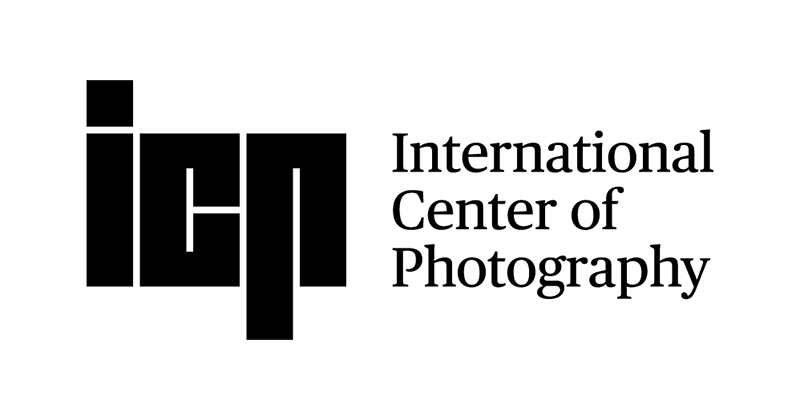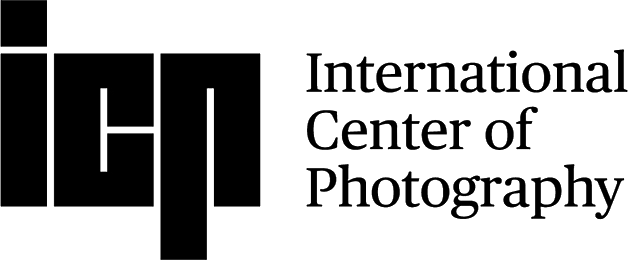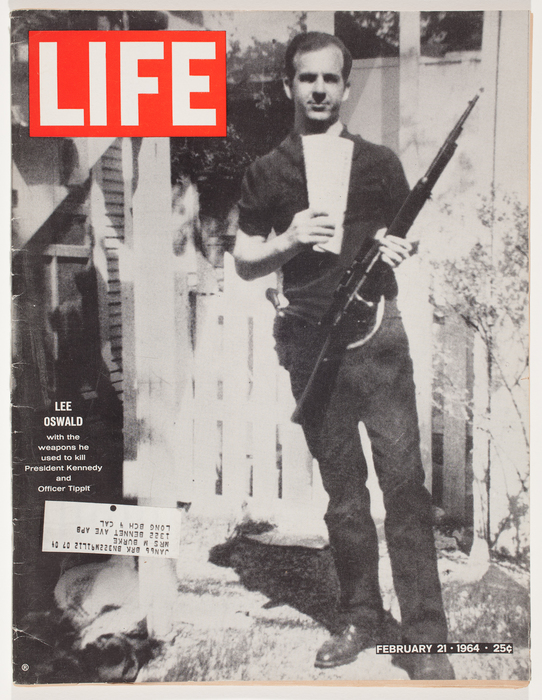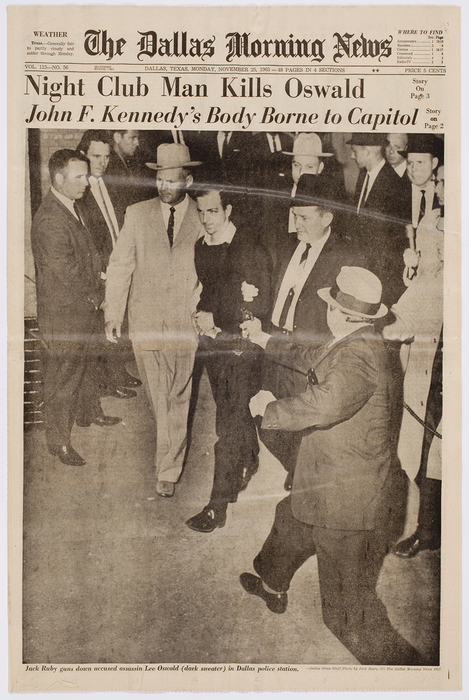08;When President John F. Kennedy was assassinated in Dallas, Texas, on November 22, 1963, the event and its aftermath were broadcast to a stunned nation through photography and television. Reporters used dramatic spot news photographs by professional photojournalists as well as snapshots by unsuspecting witnesses to explain the events: the shooting of the president, the hunt for the assassin, the swearing in of the new president, the widow's grief, the funeral, the shooting of Oswald. Viewers interpreted these photographs in various ways: to comprehend the shocking news, to negotiate their grief, to attempt to solve the crime. The combination of personal photographs assuming public significance and subjective interpretations of news images disrupted conventional views of photography as fact or evidence. JFK November 22, 1963: A Bystander's View of History examines the imaginative reception of these iconic photographs. The exhibition includes stills from Abraham Zapruder's famous footage of the assassination, as well as news photographs, snapshots by bystanders, souvenirs, and scrapbooks. Organized by ICP Chief Curator Brian Wallis on the fiftieth anniversary of the tragedy, these visual artifacts demonstrate the active role of photography in negotiating trauma and facilitating mourning.
51 Items




![[John F. Kennedy reaching into a crowd of supporters, North Hollywood, California]](https://s3.amazonaws.com/icptmsdata/c/a/p/a/capa_cornell_149_1994_447455_displaysize.jpg)
![[John F. Kennedy signing autographs for 2,500 high school students from 56 countries, White House, Washington, D.C.]](https://s3.amazonaws.com/icptmsdata/2/0/1/2/2012_94_44_421297_displaysize.jpg)
![[John F. Kennedy campaigning]](https://s3.amazonaws.com/icptmsdata/2/0/1/2/2012_92_10_446766_displaysize.jpg)
![[Television image of John F. Kennedy during presidential debate with Richard Nixon]](https://s3.amazonaws.com/icptmsdata/2/0/1/3/2013_28_1_462589_displaysize.jpg)
![[Television image of Richard Nixon during presidential debate with John F. Kennedy]](https://s3.amazonaws.com/icptmsdata/2/0/1/3/2013_28_2_430845_displaysize.jpg)
![[John F. Kennedy]](https://s3.amazonaws.com/icptmsdata/2/0/1/3/2013_21_1_440555_displaysize.jpg)
![[John F. Kennedy and others in convertible]](https://s3.amazonaws.com/icptmsdata/2/0/1/3/2013_29_1_428328_displaysize.jpg)
![[Four men with Kennedy for President poster]](https://s3.amazonaws.com/icptmsdata/2/0/1/3/2013_19_1_428028_displaysize.jpg)



![[John F. Kennedy, Jacqueline Kennedy, John Connally, and Nellie Connally in presidential limousine, Dallas]](https://s3.amazonaws.com/icptmsdata/2/0/1/3/2013_24_1_444851_displaysize.jpg)
![[John F. Kennedy, Jacqueline Kennedy, John Connally, and Nellie Connally in presidential limousine, Dallas]](https://s3.amazonaws.com/icptmsdata/2/0/1/3/2013_22_1_417002_displaysize.jpg)
![[John Connally, Nellie Connally, John F. Kennedy, and Jacqueline Kennedy in presidential limousine, Dallas]](https://s3.amazonaws.com/icptmsdata/2/0/1/3/2013_23_1_433741_displaysize.jpg)
![[John F. Kennedy, Jacqueline Kennedy, John Connally, and Nellie Connally in presidential limousine, Dallas]](https://s3.amazonaws.com/icptmsdata/2/0/1/3/2013_25_1_447034_displaysize.jpg)
![[Woman reacting in shock to news of assassination of John F. Kennedy, New York]](https://s3.amazonaws.com/icptmsdata/w/a/y/m/wayman_stan_1917_2005_409229_displaysize.jpg)
![[Frame 233 of 8mm home movie of assassination of John F. Kennedy, Dallas]](https://s3.amazonaws.com/icptmsdata/z/a/p/r/zapruder_abraham_1837_2005_447114_displaysize.jpg)
![[Frame 234 of 8mm home movie assassination of John F. Kennedy, Dallas]](https://s3.amazonaws.com/icptmsdata/z/a/p/r/zapruder_abraham_1838_2005__450967_displaysize.jpg)
![[Frame 235 of 8mm home movie of assassination of John F. Kennedy, Dallas]](https://s3.amazonaws.com/icptmsdata/z/a/p/r/zapruder_abraham_1839_2005_414497_displaysize.jpg)
![[Frame 237 of 8mm home movie of assassination of John F. Kennedy, Dallas]](https://s3.amazonaws.com/icptmsdata/z/a/p/r/zapruder_abraham_1841_2005_426010_displaysize.jpg)
![[Frame 238 of 8mm home movie of assassination of John F. Kennedy, Dallas]](https://s3.amazonaws.com/icptmsdata/z/a/p/r/zapruder_abraham_1842_2005_415400_displaysize.jpg)
![[John F. Kennedy slumping into arms of Jacqueline Kennedy after being hit by assassin's bullet, Dallas]](https://s3.amazonaws.com/icptmsdata/m/o/o/r/moorman_mary_2013_1_1_412739_displaysize.jpg)
![[8mm color movie frame of assassination of John F. Kennedy, Dallas]](https://s3.amazonaws.com/icptmsdata/2/0/1/3/2013_42_1_429272_displaysize.jpg)
![[8mm color movie frame of assassination of John F. Kennedy, Dallas]](https://s3.amazonaws.com/icptmsdata/2/0/1/3/2013_42_2_439983_displaysize.jpg)
![[Frame 310 of 8mm home movie of assassination of John F. Kennedy, Dallas]](https://s3.amazonaws.com/icptmsdata/z/a/p/r/zapruder_abraham_1843_2005__463968_displaysize.jpg)
![[Frame 311 of 8mm home movie of assassination of John F. Kennedy, Dallas]](https://s3.amazonaws.com/icptmsdata/z/a/p/r/zapruder_abraham_1844_2005_439401_displaysize.jpg)
![[Frame 312 of 8mm home movie of assassination of John F. Kennedy, Dallas]](https://s3.amazonaws.com/icptmsdata/z/a/p/r/zapruder_abraham_1845_2005_446473_displaysize.jpg)
![[Frame 313 of 8mm home movie of assassination of John F. Kennedy, Dallas]](https://s3.amazonaws.com/icptmsdata/z/a/p/r/zapruder_abraham_1846_2005_407424_displaysize.jpg)
![[Frame 314 of 8mm home movie of assassination of John F. Kennedy, Dallas]](https://s3.amazonaws.com/icptmsdata/z/a/p/r/zapruder_abraham_1847_2005_452597_displaysize.jpg)
![[Frame 315 of 8mm home movie of assassination of John F. Kennedy, Dallas]](https://s3.amazonaws.com/icptmsdata/z/a/p/r/zapruder_abraham_1848_2005_428643_displaysize.jpg)
![[John F. Kennedy's foot extending over side of presidential limousine after being hit with assassin's bullet, Dallas]](https://s3.amazonaws.com/icptmsdata/j/f/k/_/jfk_2013_71_1_442848_displaysize.jpg)
![[Re-creation of sniper's perch on sixth floor of Texas School Book Depository, Dallas]](https://s3.amazonaws.com/icptmsdata/j/f/k/_/jfk_2013_69_2_415648_displaysize.jpg)
![[Lee Harvey Oswald standing outside his home holding rifle, Dallas]](https://s3.amazonaws.com/icptmsdata/j/f/k/_/jfk_2013_69_4_424778_displaysize.jpg)
![[View from John F. Kennedy's alleged assassin's perch on sixth floor of Texas School Book Depository, Dallas]](https://s3.amazonaws.com/icptmsdata/j/f/k/_/jfk_2013_69_3_454955_displaysize.jpg)
![[Photographs presented as evidence related to assassination of John F. Kennedy to Warren Commission]](https://s3.amazonaws.com/icptmsdata/j/f/k/_/jfk_2013_69_5_440631_displaysize.jpg)
![[Lee Harvey Oswald standing outside his home holding a rifle, Dallas]](https://s3.amazonaws.com/icptmsdata/u/h/r/b/uhrbrock_don_1991_2005_446644_displaysize.jpg)

![[Lee Harvey Oswald, Dallas]](https://s3.amazonaws.com/icptmsdata/2/0/1/3/2013_18_1_453194_displaysize.jpg)
![[Television image of Lee Harvey Oswald taken into custody for alleged assassination of John F. Kennedy]](https://s3.amazonaws.com/icptmsdata/2/0/1/3/2013_44_14_440035_displaysize.jpg)
![[Television image of John F. Kennedy's accused assassin Lee Harvey Oswald being transported to county jail]](https://s3.amazonaws.com/icptmsdata/2/0/1/3/2013_44_16_446640_displaysize.jpg)
![[Television image of John F. Kennedy's accused assassin Lee Harvey Oswald being transported to county jail moments before being fatally shot by Jack Ruby]](https://s3.amazonaws.com/icptmsdata/2/0/1/3/2013_44_17_409707_displaysize.jpg)

![[Nightclub owner Jack Ruby firing bullet at point-blank range into collapsing body of Lee Harvey Oswald, Dallas Police Station]](https://s3.amazonaws.com/icptmsdata/j/a/c/k/jackson_bob_1912_2005_427959_displaysize.jpg)
![[Television image of Lyndon B. Johnson's swearing-in ceremony aboard Air Force One]](https://s3.amazonaws.com/icptmsdata/2/0/1/3/2013_44_13_423851_displaysize.jpg)
![[Television image of memorial of John F. Kennedy]](https://s3.amazonaws.com/icptmsdata/s/u/l/l/sullivan_ruth_2013_27_1_452744_displaysize.jpg)
![[Jacqueline Kennedy and her children Caroline and John Jr., followed by Rose Kennedy, leaving Saint Matthew's Cathedral for Arlington National Cemetery after John F. Kennedy's funeral, Washington, D.C.]](https://s3.amazonaws.com/icptmsdata/s/i/l/k/silk_george_1918_2005_433008_displaysize.jpg)
![[Television image of Jacqueline Kennedy and Caroline Kennedy during John F. Kennedy's funeral]](https://s3.amazonaws.com/icptmsdata/2/0/1/3/2013_44_2_413733_displaysize.jpg)
![[John F. Kennedy Jr. saluting his father's casket as it is carried from Saint Matthew's Cathedral, Washington, D.C.]](https://s3.amazonaws.com/icptmsdata/s/t/e/a/stearns_stan_1911_2005_437210_displaysize.jpg)
![[We Will Close Monday in mourning the Death of John F. Kennedy]](https://s3.amazonaws.com/icptmsdata/j/f/k/_/jfk_2013_37_1_409586_displaysize.jpg)